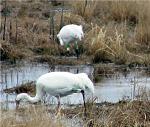Whooping Crane Migration Update: April 4, 2003
Today's Report Includes:
- They?re Off! Migration Begins for Florida Flock: Challenge Question #8
- Sara Zimorski Reports on Eastern Flock, Airborne!
- Tom Stehn Reports From Aransas: 37 Percent Are Out of There!
- First Nebraska Whooper Sighting
- Two Yearling Cranes Now Home at Necedah
- Birds on the Brain: Challenge Question #9
- Birds of a Feather Sticking Together: But How Unusual
- Tailwinds and ___? Discussion of Challenge Question #6
They?re Off! Migration Begins for Florida Flock
 |
| Note: This map shows only migration of the HY2002 chicks, and yearling #5 who is traveling with them. |
Use the data to see if you can calculate:
Challenge Question #8:
"How many miles did the group of 15 cranes cover on their first day of migration?"
(To respond to this question, please follow the instructions
below.)
HINT: If you need a refresher in how to calculate, see this lesson:
Sara Zimorski Reports on Eastern Flock, Airborne!
Sara Zimorski |
 |
Evening roost location
the first night of their migration north. Credit Richard Urbanek |
Day 1, April 1:
Crane #5-01 (the year-old crane from the first ultralight-led migration) and the 16 chicks left the release pen at Chassahowitzka around 9:15 in the morning, after roosting outside the pen in E-Creek the previous evening. When Lara called in on the cell phone at 8:00 she heard all the birds' signals, but when she called again at 9:00 the signals were weak, which meant the birds were not near the pen. She let Richard know and he started listening from his location farther north at St. Martins. When Lara called again at 10:00 she did not hear any radio signals, and by 10:15 Richard heard them going over St. Martins. Lara began tracking the birds from the truck while Richard finished getting some things together, then he began tracking as well. By 10:45 chicks #9 and #14 had split from the main group remaining in the central Gulf Coast area. These two birds were not tracked as Richard and Lara continued tracking the main group of 15. After several hours Lara returned to Chassahowitzka and Richard continued following the group of 15 till they landed in Lee County, GA at 1808, after flying (See Challenge Question #8, above) miles in 8.9 hours.
Meanwhile Colleen was planning on flying around WI to listen for last year?s Cranes #1, #2, and #7. But when we learned of the chicks? departure, her plans quickly changed and her flight got quite a bit longer. Instead of flying around Necedah and Horicon, she headed south to meet up with Richard and Lara and help track the birds from the air.
After returning to Chassahowitzka, Lara went to the pen to look for Cranes #9 and #14. Neither bird was there. After more searching, Lara detected #9's signal north of Chassahowitzka in St. Martins Marsh, but could not find #14.
Day 2, April 2:
In the morning Lara, and Colleen in the plane, heard #14's signal in Dixie County, FL. Another day of tracking began with Lara following #9 all day to Colquitt County, GA, and Colleen following #14 all day to Baker County, GA. Meanwhile Richard followed the group of 15 to Meigs County, TN where they spent the night.
Day 3, April 3:
We don't have all the details, but we do know tracking has continued today with the group and the two individual birds on the move again followed by their own ICF tracker."
From Operation Migration headquarters, Heather Ray adds this exciting note: "Richard Urbanek was able to watch the flock of 15 this morning as they caught and rode thermals over the "beast" (aka Waldenridge) Remember the pilots had to lead them over this monster ridge at 4000 feet altitude?" Go birds!
Tom Stehn Reports From Aransas: 37 Percent Are Out of There!
 |
Tom Stehn |
Dear Journey North,
We had tremendous weather for migration March 31 and April 2. The whooping cranes took full advantage of the strong tail winds and clear skies. My census flight on April 2 showed that 54 whooping cranes (29% of the flock) started the migration in the past week, and that 68 total (37% of the flock) have departed so far this spring. I also made a short migration, leaving work one hour early yesterday to go windsurfing in the winds, gusting up to 30 miles per hour. I just couldn?t sit at the desk any longer. With those tail winds, cranes would be averaging about 60 miles per hour as they migrate. This we know from 20 years ago, when we had radio transmitters on the cranes and were actually following them in airplanes.
The migration appears to be right on schedule since the majority of cranes usually depart April 4-12. I expect most of the cranes to be headed north by the middle of April. This may be a year where it is advantageous NOT to leave early. It is still very cold up north. It was about 10 degrees F on April 1, and still very frozen in Wood Buffalo National Park where the cranes will end up about one month from now."
It sounds like those Texas winds were welcome to both "Windsurfing Tom" and the fleeing flock! In his full report, Tom answers the Challenge Question he gave you last week (also below), and more. You?ll find out: What evidence does Tom give that a pair of cranes starting the migration may influence their neighbors to also start at the same time or soon thereafter? Tom is watching crane in particular with a bit of worry. What?s the problem?
First Nebraska Whooper Sighting
 |
Upon hearing Wally?s report, Tom Stehn said, "Yes, the family group seen in Nebraska on the Loup River March 31 was most likely the unbanded Lakeside family that was the first family group to depart Aransas, having left between March 20 and March 26. There?s a less likely chance that perhaps it was a family group that could have departed Aransas on March 27, but I have no way of knowing if any cranes departed on the 27th other than to record the favorable weather conditions for migration on that day. It would have been a very fast trip if it was a family that had departed March 27 to be in Nebraska March 31."
With cranes now overhead in the Midwest and the East, are you in line to see the rare and wondrous sight of migrating whoopers? Check the paths on the map (see Web). And if you wonder where else you can see whooping cranes, find out here:
Two Yearling Cranes Now Home at Necedah
 |
Crane #'s 1-01 and 2-01
back at the Necedah National Wildlife Refuge. 04/04 Credit Rich King |
"Cranes #1 and #2 left their wintering site in Pasco County, FL on the morning of March 25. The birds flew 210 miles in 7 hours and stopped for the night in Berrien County, GA. On March 26 they flew 180 miles in 5.4 hours before encountering a severe thunderstorm. They retreated 21 miles south and spent the night in Henry County, GA. On March 27 they flew again, but the birds got ahead of Richard Urbanek, who was tracking them, and an exact roost location was not determined. On March 28 there were again strong winds out of the south and the birds remained ahead of Richard. He last detected a faint signal to the northwest in central Indiana around 2:00. As a thunderstorm approached and no more signals were detected, Richard returned to FL to monitor the 2002 birds and prepare for their departure. On the evening of March 30 these two birds were positively identified by DNR staff in Lake County, IN. They were observed again the next morning for several hours before they took off, flying NW. The next morning Rich King, biologist at the Necedah National Wildlife Refuge detected the radio signal of #1, and on April 2 both birds were seen foraging in the marshes near the chick/ultralight training sites at Necedah. Here they are, home again! (See photos on the Web.) Crane #5, as you know, is migrating with the group of HY2002 chicks, whom he lived with all winter. Crane #6, found in Dodge County, Wisconsin during an aerial search on March 25, has remained there since then with numerous sandhill cranes. Female Crane #7 was last seen in central Indiana on March 17."
Try This! Write a paragraph that compares and contrasts the FIRST and the SECOND spring journeys north for HY01 Cranes #1 and #1. You can see details of last spring?s journey north here:
Birds on the Brain
CRANE #9 is a small and
submissive female. |
Challenge Question #9:
"Why do you think the whooping cranes in the new Eastern flock are given numbers rather than names, like the manatees that are tracked by Journey North?"
(To respond to this question, please follow the instructions
below.)
Birds of a Feather Sticking Together: But How Unusual
So far, the group of 15 whoopers is sticking together in a flock size that?s unusual for this species. Unlike Sandhills that migrate in big flocks, birds in the Aransas-Wood Buffalo flock of Whooping Cranes normally migrate in families or small groups. Why do you suppose the young birds are sticking together so far? Do you think they will continue to migrate as a group?
Tailwinds and ___? Discussion of Challenge Question #6
Last time Tom Stehn had this question for you: "Can you think of what other weather condition the cranes need that is equally as important as tail winds for the migration?"
"Another weather condition that is equally as important as tail winds is dry weather," wrote Lauren, Jordan, Cindy and Ruchi from Iselin Middle School/grade 7A. And Tom Stehn says, "My answer would be clear skies. With the sun shining, the land warms up and creates thermal currents that rise off the ground. These rising air currents provide lift for the cranes and allow them to gain altitude a little over 1 mile high above the ground. The cranes then glide to the north, traveling over 60 miles an hour as they descend to about 1,000 feet before they catch the next thermal current. Thus, the cranes migrate by soaring and gliding using their huge wing spans to ride the lifting air.
"Cranes don?t fly in a straight line and flap their wings the way geese do. They would get too tired doing that for very long. Thus, sunny skies and tail winds are the two most important conditions the cranes look for when deciding whether or not to migrate farther north. If conditions aren?t favorable, the cranes will just stay put for however long it takes the weather to improve. The weather can?t improve much here in Texas. It is gorgeous. If you live up north, have faith. Warmer weather is coming soon."
You can find out much more about thermals and how cranes fly in this Journey North lesson:
How to Respond to Today's Challenge Questions:
IMPORTANT: Answer only ONE question in each e-mail message.
1. Address an e-mail message to: jn-challenge-crane@learner.org
2. In the Subject Line of your message write: Challenge
Question #8 (or #9).
3. In the body of EACH message, give your answer to ONE of the questions
above.
The Next Crane Migration Update Will Be Posted on April
11, 2003.
Copyright 2003 Journey North. All Rights
Reserved.
Please send all questions, comments, and suggestions to our feedback form
![]()
![]()
![]()
![]()
![]()
![]()










